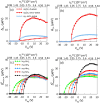Effect of electrostatic confinement on the dome-shaped superconducting phase diagram at the LaAlO3/SrTiO3 interface
- PMID: 39478102
- PMCID: PMC11525793
- DOI: 10.1038/s41598-024-77460-0
Effect of electrostatic confinement on the dome-shaped superconducting phase diagram at the LaAlO3/SrTiO3 interface
Abstract
The two-dimensional electron gas (2DEG) at the LaAlO[Formula: see text]/SrTiO[Formula: see text] (LAO/STO) interface exhibits gate-tunable superconductivity with a dome-like shape of critical temperature as a function of electron concentration. This behavior has not been unambiguously explained yet. Here, we develop a microscopic model based on the Schrödinger-Poisson approach to determine the electronic structure of the LAO/STO 2DEG, which we then apply to study the principal characteristics of the superconducting phase within the real-space pairing mean-field approach. For the electron concentrations reported in the experiment, we successfully reproduce the dome-like shape of the superconducting gap. According to our analysis such behavior results from the interplay between the Fermi surface topology and the gap symmetry, with the dominant extended s-wave contribution. Similarly as in the experimental report, we observe a bifurcation effect in the superconducting gap dependence on the electron density when the 2DEG is electrostatically doped either with the top gate or the bottom gate. Our findings explains the dome-shaped phase diagram of the considered heterostucture with good agreement with the experimental data which, in turn, strongly suggest the appearance of the extended s-wave symmetry of the gap in 2DEG at the LAO/STO interface.
Keywords: LAO/STO interface; Oxide interfaces; Unconventional superconductivity.
© 2024. The Author(s).
Conflict of interest statement
The authors declare no competing interests.
Figures






Similar articles
-
Thermal stability of 2DEG at amorphous LaAlO3/crystalline SrTiO3 heterointerfaces.Nano Converg. 2016;3(1):7. doi: 10.1186/s40580-016-0067-9. Epub 2016 Apr 1. Nano Converg. 2016. PMID: 28191417 Free PMC article.
-
Nanopatterning of Weak Links in Superconducting Oxide Interfaces.Nanomaterials (Basel). 2021 Feb 4;11(2):398. doi: 10.3390/nano11020398. Nanomaterials (Basel). 2021. PMID: 33557305 Free PMC article.
-
Interface Energetics and Charge Carrier Density Amplification by Sn-Doping in LaAlO3/SrTiO3 Heterostructure.ACS Appl Mater Interfaces. 2015 Jul 8;7(26):14294-302. doi: 10.1021/acsami.5b02770. Epub 2015 Jun 23. ACS Appl Mater Interfaces. 2015. PMID: 26062403
-
Switchable induced polarization in LaAlO3/SrTiO3 heterostructures.Nano Lett. 2012 Apr 11;12(4):1765-71. doi: 10.1021/nl3001088. Epub 2012 Mar 13. Nano Lett. 2012. PMID: 22400486
-
Electron pairing and nematicity in LaAlO3/SrTiO3 nanostructures.Nat Commun. 2023 Nov 23;14(1):7657. doi: 10.1038/s41467-023-43539-x. Nat Commun. 2023. PMID: 37996464 Free PMC article.
References
-
- Reyren, N. et al. Superconducting interfaces between insulating oxides. Science317, 1196–1199 (2007). - PubMed
-
-
Joshua, A., Pecker, S., Ruhman, J., Altman, E. & Ilani, S. A universal critical density underlying the physics of electrons at the
 interface. Nat. Commun.3, 1129 (2012).
-
PubMed
interface. Nat. Commun.3, 1129 (2012).
-
PubMed
-
Joshua, A., Pecker, S., Ruhman, J., Altman, E. & Ilani, S. A universal critical density underlying the physics of electrons at the
-
-
Biscaras, J. et al. Two-dimensional superconducting phase in
 heterostructures induced by high-mobility carrier doping. Phys. Rev. Lett.108, 247004 (2012).
-
PubMed
heterostructures induced by high-mobility carrier doping. Phys. Rev. Lett.108, 247004 (2012).
-
PubMed
-
Biscaras, J. et al. Two-dimensional superconducting phase in
-
-
Monteiro, M. et al. Band inversion driven by electronic correlations at the (111)
 interface. Phys. Rev. B99, 201102 (2019).
interface. Phys. Rev. B99, 201102 (2019).
-
Monteiro, M. et al. Band inversion driven by electronic correlations at the (111)
Grants and funding
LinkOut - more resources
Full Text Sources
Miscellaneous

 interface. Nat. Commun.6, 8239 (2015).
-
interface. Nat. Commun.6, 8239 (2015).
-
